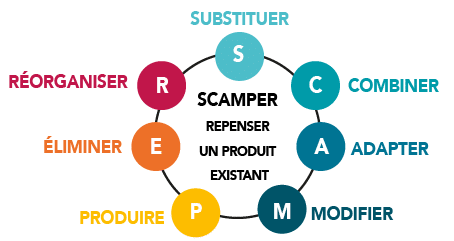In a sector as competitive as digital marketing, creativity is much more than an asset - it's a strategic skill that helps you stand out from the crowd. It enables us to capture attention, propose innovative solutions and create memorable experiences. But how do you develop this key skill? So how can you stimulate your creativity to revolutionise your approach to marketing? Clarisse Popower, an expert in responsible digital marketing, reveals the five golden rules for unleashing the full creative potential of marketers.

In the age of digital transformation and information overload, standing out from the crowd has become a challenge. The public is increasingly demanding, competitors are numerous and trends are constantly changing.
As a result, marketers have to juggle innovation, immediate results and often repetitive processes. They find themselves locked into a routine that limits their ability to innovate. Many are asking themselves: how can I maintain a creative spirit while working in a structured environment? How do you combine performance and innovation?
There are practices for cultivating creativity, even in the most constrained contexts. With simple strategies and techniques and gradual changes, you can unleash your creative potential and tackle everyday challenges with a renewed spirit.
This will enable marketers to use their creativity proactively in their marketing campaigns.

Take the test! How creative are you?
Whatever your profession, creativity is a key resource for innovating, solving problems and adapting to challenges: managing the unexpected, optimising your processes, devising your action plan, etc. Assess your strengths, identify your areas for improvement and unleash your full potential by taking this fun test.
Rule 1: stimulate your curiosity by getting out of your comfort zone
Creativity is born from the meeting of different ideas. In marketing, differentiation is essential. Stepping out of your comfort zone allows you to find new and unexpected inspiration for original, hard-hitting campaigns.
Example: Red Bull's approach
Going beyond the traditional framework of energy drink advertising, Red Bull invested in extreme events (adventure sports) to connect the brand with a new audience. The result: strong, unique brand identification.
Best practice
To stimulate your curiosity, explore other sectors of activity: fashion, tech, art... and draw inspiration from them to innovate your marketing strategies.
For example, how can storytelling techniques in the film industry feed into your campaigns?
Rule 2: create an environment conducive to creativity
The environment directly influences the quality of the ideas generated. In marketing, a a flexible and stimulating environment frees up the creativity needed to develop unexpected campaigns.
Example: Pixar's brainstorming room
To stimulate the exchange of ideas, Pixar has designed open, unconventional spaces where everyone can express themselves without hierarchy. This model has inspired other companies, particularly in digital marketing, to rethink their meeting spaces.
Best practice
Incorporate stimulating visual elements into your office or meeting room. Introduce free creative time where the team can come up with ideas without constraint.
Examples
- Put up a whiteboard or a wall of post-it notes to encourage spontaneous writing and drawing.
- Set up a digital box or application where employees can share their thoughts.
Rule 3: develop creative habits on a daily basis
La repeating creative habits in a structured environment allows marketers to adapt quickly to new trends and to innovate more frequently.
Example: daily standup at HubSpot
Every day, HubSpot's marketing teams get together for a 15-minute creative brief where everyone shares an innovative idea. These quick sessions help to generate ideas for content and lead acquisition campaigns.
Best practice
Get into the habit of spending 10 minutes a day jotting down your campaign ideas or thinking about a marketing issue from a new angle.
For example, what unexpressed customer needs could you anticipate?
Rule 4: use tools to structure your ideas
In marketing, it's not enough to have ideas: you have to be able to structure and implement them effectively. THE creativity tools are enabling us to explore innovative avenues and test different approaches.
Example: Nike's brainstorming sessions using the SCAMPER method
SCAMPER is a method of substituting, combining, adapting, modifying, finding alternative uses for, eliminating and reorganising elements of an idea or product. This has helped Nike to offer personalised campaigns tailored to the changing expectations of its customers.

Example : Nike By You. The concept: "It's up to you to find out! Create the perfect shoe with Nike By You, Nike's co-creation service for members. A touch here, a touch there, have fun customising a shoe that's just like you.
Read also
Best practice
Use SCAMPER, the six De Bono hatsor digital tools such as Miroa virtual whiteboard, to facilitate online brainstorming sessions and enrich your marketing concepts.
To launch a digital campaign for a personalised sports training programme, digital marketing manager Antoine used the SCAMPER method.
Rule 5: Be positive and experiment
Not every marketing campaign can be a success, but every failure is an opportunity to learn. Marketers who adopt an approach of constant experimentation eventually identify what works.
Example: Spotify
When launching certain features, Spotify has often failed to reach its target audience. However, these tests enabled the company to better understand users' expectations, and thus to perfect its offerings. Today, Spotify is a master in the art of analysing data to adjust its products in real time.
Best practice
Test, fail, learn, then try again. Create a culture of rapid iteration in your marketing team to learn from each campaign.
Example
Does your marketing team really learn from every failure?
Beyond the results, do you take the time to analyse what worked (or didn't) and adjust your next actions? How can you integrate a culture of rapid iteration to transform each test into a lever for continuous improvement?
Would you like to go further and structure your creative approach?
Discover the training programme Marketers: develop your creativity, unleash your creative potential to excel in marketing. Simulation games, creativity tests, idea pitches... Using practical tools and supervised exercises, this training course guides you step by step to make creativity an essential lever in your marketing strategies.
Example of a practical exercise: pitching an idea in 5 key steps
Powerful hook
Grab attention with a statistic, a question or an anecdote.
"80 % of consumers abandon their shopping basket due to a lack of transparency."
Problem identified
Explain your target's need or frustration.
"Customers are looking for simple insurance, but are lost when faced with complex offers.
Proposed solution
Present your idea and explain how it addresses the problem.
"Our interactive simulator gives you a quick, clear estimate in just 30 seconds.
Evidence and benefits
Back up your solution with figures or customer feedback.
"This course increases the conversion rate by 30 % and reduces abandonment.
Call to action
Clearly indicate the next step.
"We're looking for partners to preview the simulator. Who is interested?"
A good pitch is concise, impactful and action-oriented!
Testimonial from a participant :
"Before I took the ORSYS training course on developing creativity, I often felt limited in my ideas. Our campaigns are effective but sometimes lack originality and impact. I needed concrete methods to break out of the traditional patterns and bring real renewal to our strategies. We've used the methods in our actual cases, and that's a real plus! Valérie, Marketing Manager.
To boost your creativity in marketing, simply apply these 5 golden rules on a daily basis: stimulate your curiosity, create the right environment, adopt creative habits, structure your ideas with the right tools and turn failure into opportunity. In this way, you'll strengthen your ability to innovate.





